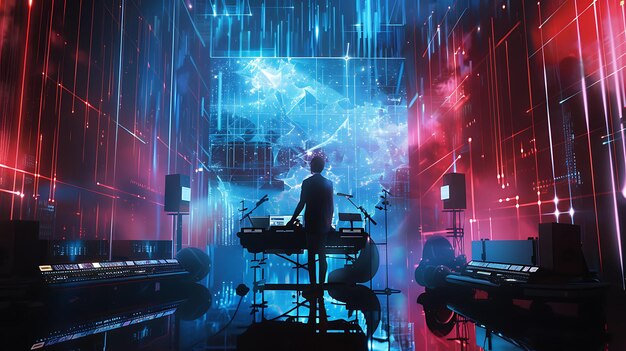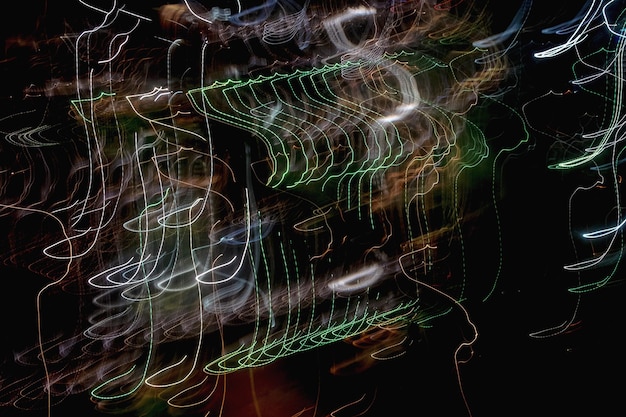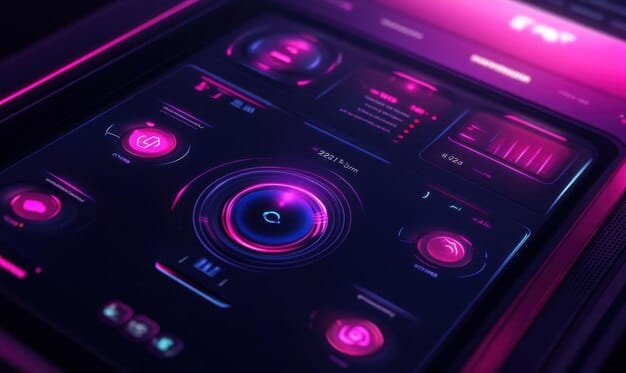AI-Powered DAWs & Underground Music: Reshaping Production by 2025

By 2025, AI-powered DAWs are poised to profoundly reshape underground music production by democratizing advanced tools, fostering innovative sound design, and automating tedious tasks, ultimately empowering artists to focus on creative expression and accelerate their workflow in unprecedented ways.
The soundscape of underground music has always thrived on innovation, raw creativity, and a rebellious spirit that pushes boundaries. Now, as artificial intelligence rapidly integrates into every facet of our lives, a crucial question emerges: How will AI-powered DAWs reshape underground music production by 2025? This isn’t just about automation; it’s about a fundamental shift in how artists create, collaborate, and define the very essence of electronic music.
The Dawn of AI in Digital Audio Workstations
The integration of artificial intelligence into Digital Audio Workstations (DAWs) represents a paradigm shift, moving beyond simple plugins to intelligent systems that can learn, suggest, and even generate musical elements. This evolution promises to transform not only the tools available but also the very creative process for underground artists. Many producers currently grapple with steep learning curves and significant time investments to achieve desired sounds, but AI could streamline these challenges.
This new wave of AI-powered DAWs offers features that range from sophisticated sound synthesis to intelligent mixing and mastering assistance. Artists might find themselves interacting with systems capable of understanding their creative intent, translating abstract ideas into tangible sonic outputs with remarkable efficiency. The initial skepticism surrounding AI’s role in creative fields is gradually giving way to an understanding of its potential as a powerful collaborative partner, rather than a mere replacement for human talent.
Automating Tedious Tasks
One of the most immediate benefits AI brings to DAWs is the automation of repetitive and time-consuming tasks. This includes everything from beat programming to tedious audio editing.
- 🤖 Intelligent Beat Generation: AI can analyze existing rhythmic patterns and generate new, complex beats that align with a specific genre or mood, offering endless variations.
- 🧹 Automated Mixing Assistance: AI algorithms can suggest optimal EQ settings, compression parameters, and reverb levels, helping producers achieve a professional sound faster.
- ✂️ Smart Editing and Arrangement: AI can identify repetitive phrases, suggest rearrangements, or even automatically trim silence from audio tracks, streamlining the editing workflow.
These capabilities don’t aim to remove the producer from the equation but rather to free up valuable time and mental energy. By offloading the more mechanical aspects of music production, artists can dedicate more of their focus to the core creative elements: melody, harmony, and overall artistic vision. This shift is particularly impactful in underground scenes, where resources might be limited, and every minute saved translates into more creative output.
Before AI, achieving a polished sound often required years of experience and a deep understanding of audio engineering principles. Now, AI-powered tools act as intelligent co-pilots, democratizing access to professional-quality production. This means emerging artists with compelling ideas but limited technical know-how can produce tracks that stand shoulder-to-shoulder with those from seasoned veterans.
Empowering Creativity Through AI-Driven Sound Design
AI’s influence extends far beyond automation; it is fundamentally transforming how artists approach sound design, offering unprecedented avenues for sonic exploration and innovation crucial for the underground music scene. Underground music thrives on unique textures and experimental sounds, and AI is proving to be a potent catalyst for this.
The promise here is not to homogenize sound but to provide tools that amplify individual creative voices. AI can analyze vast datasets of audio, identify patterns, and then generate entirely new sounds or manipulate existing ones in ways that defy conventional synthesis methods. This enables producers to craft signature sounds that are truly one-of-a-kind.
Generative Soundscapes and Textures
Generative AI can create complex, evolving soundscapes and textures that would be incredibly difficult or impossible to achieve manually. This opens up new frontiers for experimental underground genres aiming for immersive auditory experiences.
- 🌌 Algorithmic Textural Synthesis: AI can learn from diverse audio inputs to generate evolving atmospheric layers, drone textures, or percussive elements with unique sonic fingerprints.
- 🔮 Dynamic Effects Processing: AI can intelligently apply and modulate effects in real-time based on musical input, creating adaptive sonic transformations.
- 🧠 Style Transfer for Audio: Imagine applying the sonic characteristics of one track to another, creating entirely new hybrid sounds without laborious manual reconstruction.
These advanced capabilities mean that producers are no longer limited by their knowledge of traditional synthesis methods or the presets available in their DAWs. Instead, they can guide an AI to explore sonic territories that might currently lie beyond human conceptualization. This is particularly exciting for underground artists who constantly seek to break new ground and differentiate their sound within a saturated market.
The ability to rapidly prototype and experiment with complex sound ideas is a game-changer. An artist might feed a short vocal sample into an AI, asking it to generate a dozen variations ranging from metallic to ethereal, and instantly get new creative impulses. This iterative process, accelerated by AI, allows for a much more fluid and intuitive approach to sound design, pushing the boundaries of what is sonically possible within underground genres.

Democratizing Access and Lowering Barriers to Entry
Historically, professional music production has been a costly endeavor, requiring expensive equipment, specialized software, and extensive training. This often placed significant barriers for aspiring underground artists, particularly those without substantial financial resources. AI-powered DAWs are set to dismantle many of these obstacles, making high-quality production more accessible than ever before.
By integrating sophisticated features that previously required dedicated hardware or advanced plugins, AI can reduce the overall expenditure needed to set up a functional studio. This democratization is vital for the underground scene, which often flourishes on DIY ethics and the contributions of artists from diverse backgrounds who might not have access to mainstream resources.
Affordable Professional Tools
The cost of entry for aspiring producers can be prohibitive. AI can integrate complex functionalities into more affordable software packages, lowering the financial hurdle.
- 💰 Cost-Effective Mastering: AI-driven mastering plugins can provide near-professional results at a fraction of the cost of traditional mastering engineers, crucial for indie artists.
- 💡 Intelligent Tutorials and Guidance: Some DAWs are starting to incorporate AI that can offer real-time feedback and tutorials, acting as a virtual mentor for beginners.
- 🔄 Reduced Hardware Dependency: As AI takes on more processing tasks, the need for high-end dedicated hardware for certain functions may diminish, further reducing setup costs.
This means that a talented individual with a laptop and an internet connection could potentially produce tracks that compete in quality with those made in multi-million dollar studios. The playing field is being leveled, allowing a wider array of voices and creative styles to emerge from the underground. This influx of new talent, unburdened by traditional financial constraints, is likely to inject a fresh wave of innovation into the scene.
Beyond just cost, AI also lowers the knowledge barrier. Complex audio engineering concepts, previously requiring years of study or apprenticeship, can now be guided by AI assistants. For instance, an AI might analyze a drum track and suggest optimal compression settings, explaining “why” it chose those settings, thus educating the user in real-time. This blend of assistance and education accelerates the learning process, empowering new artists to quickly develop their production skills and realize their musical visions.
The Evolving Role of the Producer and Human-AI Collaboration
As AI takes on more functions within DAWs, the role of the human producer is inevitably going to evolve. This isn’t about AI replacing human creativity, but rather reshaping it into a more curatorial and visionary endeavor. The producer’s focus will shift from the technical mechanics to the overarching artistic direction, becoming more akin to a conductor or a creative director.
The collaboration between human and AI is where the true potential lies. AI provides the tools and suggestions, but the human artist brings the intention, emotion, and unique perspective that define underground music. It’s a dynamic partnership where each augments the other’s strengths, leading to entirely new creative outcomes. The fear of creativity becoming sterilized by AI is unfounded if humans remain firmly in the driver’s seat of artistic decision-making.
New Creative Workflows
AI integration will foster new workflows that encourage experimentation and rapid iteration, allowing producers to explore more creative avenues than ever before.
* Producers might start with an AI-generated motif, then humanize it with intricate flourishes.
* AI could develop a basic track structure, which the artist then fills with bespoke sound design.
* Instead of tedious sound design from scratch, producers prompt AI with mood descriptors.
* A/B testing of different mix and master versions can be done instantly with AI suggestions.
The future producer might spend less time tweaking individual parameters and more time interacting with AI systems, guiding them with high-level artistic commands. This allows for a focus on macro-level composition and arrangement, enabling artists to finish projects faster and produce a greater volume of high-quality work. This accelerated output could revitalize the underground scene by making it more reactive and prolific.
Furthermore, AI can act as an objective third party, offering constructive criticism or alternative perspectives that a human might overlook. For example, an AI could analyze a track and point out moments of rhythmic predictability or suggest harmonic variations that add complexity. This feedback loop, powered by AI, transforms the solitary act of production into a more collaborative process, even when working alone. The synergy between human intuition and AI processing power unlocks new dimensions of creative expression.

Challenges and Ethical Considerations for Underground Music
While the benefits of AI in DAWs are compelling, it’s crucial for the underground music community to address the inherent challenges and ethical considerations. The rapid advancement of AI technology brings with it questions about originality, copyright, and the very definition of artistic ownership. These are not minor issues; they strike at the heart of what gives underground music its authenticity and value.
The underground scene often champions originality and a rejection of commercially formulaic sounds. Therefore, understanding how AI’s generative capabilities might intersect with these values is paramount. It’s a delicate balance between leveraging powerful new tools and preserving the integrity and human element of music creation.
Addressing Concerns of Originality and Copyright
The ability of AI to generate music raises complex questions about intellectual property and the unique fingerprint of an artist.
- ⚖️ Authorship Attribution: Who owns the copyright of a track developed with significant AI contribution? The artist, the AI developer, or both?
- 🎭 Avoiding Homogenization: Will easily accessible AI tools lead to a more uniform sound across underground genres, diluting their distinctive edge?
- 🕵️♀️ Detecting AI-Generated Content: As AI becomes more sophisticated, how will listeners and industry professionals differentiate between human and AI-authored music?
These questions require thoughtful discussion and potentially new legal frameworks to ensure artists are fairly compensated and their unique styles protected. The underground community, with its history of challenging norms, is uniquely positioned to lead these conversations and advocate for ethical AI use in music. It’s about establishing guidelines that promote innovation without stifling individual creativity or devaluing human effort.
Furthermore, the “black box” nature of some AI algorithms means that producers might not fully understand *how* certain sounds or compositions were generated. This lack of transparency could lead to a disconnect between the artist’s intent and the AI’s output, challenging the notion of conscious creation. Transparency in AI music tools, allowing artists to peer into the generative process, will be crucial for maintaining creative control and fostering trust. The conversation is not just about legality, but also about the philosophical implications of shared creation and the future of artistic ownership in a technologically advanced landscape.
Beyond 2025: Predictive Trajectories for AI in Underground Production
Looking beyond 2025, the trajectory of AI in underground music production suggests even more profound transformations. The current advancements are merely the tip of the iceberg, hinting at a future where the lines between human and machine creativity become increasingly blurred, yet in a way that empowers artists rather than diminishes them. We can anticipate AI becoming an even more intuitive and integrated partner in the creative workflow.
The pace of AI development is accelerating, meaning that features that seem futuristic today may become commonplace far sooner than expected. This rapid evolution will continue to challenge our perceptions of artistic creation and what it means to be a “producer” in the digital age. The underground, always at the forefront of experimentation, will undoubtedly be a key testing ground for these emerging technologies.
Hyper-Personalized Creative Assistants
Future AI in DAWs might evolve into hyper-personalized creative assistants that deeply understand an individual artist’s style, preferences, and creative blocks.
* 🤝 Predictive Composition: AI could learn an artist’s preferred melodic or harmonic patterns and suggest coherent continuations or variations in real-time.
* 🧘♀️ Emotionally Responsive AI: Systems might interpret an artist’s emotional state or musical intent and adapt their suggestions accordingly, creating a more symbiotic relationship.
* 🌐 Collaborative Networks: AI could facilitate global collaborations by suggesting artists with complementary styles and even bridging language barriers in creative communication.
These advanced AI systems would move beyond generic suggestions, becoming an extension of the artist’s own creative mind, anticipating needs and offering solutions before they are even consciously articulated. This level of integration promises to accelerate the creative process to an unprecedented degree, allowing artists to materialize complex ideas with astonishing speed. The feedback loop between human and AI will become almost instantaneous, fostering an environment of continuous experimentation and refinement.
We might also see AI-powered DAWs facilitating entirely new forms of music. Imagine AI systems that can generate entire multitrack compositions based on abstract textual descriptions or even biometric data from the artist. This could lead to genuinely novel genres emerging from the underground, pushing the boundaries of what we currently define as music. The influence of AI will not be to replace creativity but to unlock new realms of possibility, transforming the underground music landscape in ways we can only begin to imagine.
| Key Point | Brief Description |
|---|---|
| 🚀 AI-Driven Workflow Automation | AI automates repetitive tasks like beat creation, mixing, and arrangement, freeing artists for creative focus. |
| ✨ Enhanced Sound Design | Generative AI fosters unique soundscapes and textures, pushing sonic boundaries for experimental genres. |
| 🔓 Democratized Production | Lowers costs and learning curves, making high-quality production accessible to a broader range of underground artists. |
| 🤔 Ethical & Copyright Challenges | Raises critical questions about originality, authorship, and the potential for homogenization in music creation. |
Frequently Asked Questions About AI in Underground Music Production
No, AI-powered DAWs are not expected to replace human producers. Instead, they will act as powerful tools and collaborators, automating tedious tasks and generating new ideas. This shift allows human artists to focus more on creative direction, emotional expression, and artistic vision, ultimately amplifying their capabilities rather than diminishing their role in underground music production.
AI is poised to enhance creativity by offering new avenues for sound design, generating novel musical elements, and accelerating experimental workflows. While concerns about homogenization exist, most AI tools are designed to be guided by the artist, ensuring uniqueness. The focus remains on human originality, with AI serving as a catalyst for unparalleled sonic exploration and innovation in underground genres.
The primary benefits include automating repetitive tasks like mixing and beat programming, democratizing access to professional-grade tools by lowering costs and learning curves, and fostering innovative sound design through generative capabilities. These advantages empower underground artists to produce high-quality music more efficiently, allowing them greater freedom to experiment and express their unique artistic visions.
Yes, significant ethical concerns exist, primarily around originality, copyright, and authorship attribution. As AI contributes more to compositions, questions arise about who owns the intellectual property and how to prevent a potential homogenization of sound. The underground community will need to engage in discussions to establish guidelines that protect creative integrity and ensure fair compensation for human artists.
Beyond 2025, AI-powered DAWs are expected to become highly personalized and intuitively collaborative. They may evolve into intelligent creative assistants that deeply understand an artist’s style, offer predictive composition, and even respond to emotional cues. This will likely lead to hyper-efficient workflows and the emergence of entirely new genres, further pushing the boundaries of human-AI artistic interaction in underground music.
Conclusion
The integration of AI into Digital Audio Workstations is not merely a technological upgrade; it marks a pivotal moment for underground music production. While it brings forth complex questions regarding authenticity and ownership, it also ushers in an era of unprecedented creative possibility. By 2025, AI-powered DAWs will have firmly established themselves as indispensable tools, automating the mundane, inspiring the innovative, and ultimately empowering artists to chart new sonic territories. The underground’s spirit of experimentation and boundary-pushing is perfectly poised to harness these advancements, ensuring a future where creativity remains at the forefront, augmented and amplified by intelligent machines, rather than overshadowed by them. The future sound of underground lies in this dynamic collaboration.





